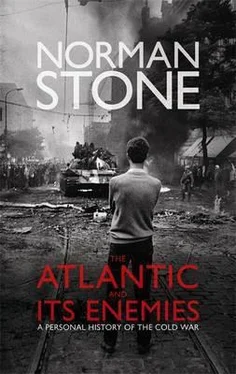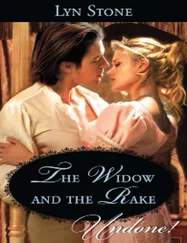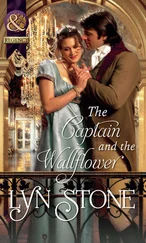At any rate, here was a grinning Khrushchev going round the West, even being received with rapture by ambitious hostesses in California and talking agriculture with prominent American farmers. A machinery for East-West relations was coming into existence. At the United Nations and in foreign ministries, a bureaucracy was to emerge, with an interest in common matters, such as disarmament talks or ‘summits’, which were supposed, generally quite wrongly, to make for personal friendships that would solve the various international problems. Quite soon, American farmers were saving the Soviet population from the consequences of Moscow’s misdeeds over agriculture (in 1914 Russia had been the greatest grain exporter in the world). Grain exports started in 1955, and were generally paid for, through a credit system, by the American taxpayer. However, there was an obvious problem, in that the People’s Democracies that Stalin had set up were considerable counter-propaganda. The contrast between Austria and Hungary was illustrative. Vienna was remaking itself as an historic city. Budapest, its twin, was still pockmarked by bullet holes, the splendid boulevards of nineteenth-century Pest dimly lit, empty, and marked only by occasional dingy shops. Any appeal to the West would mean getting rid of the little Stalinists who ran these places, each with its own miniature Iron Curtain, complete with savage Alsatians (a stuffed one, in heroic biting mode, was on display in the Prague museum of the security police, which occupied part of the old German university).
Getting rid of these little Stalinists was not easy. Czechoslovakia had her own native Communist movement of some strength, but in Poland and Hungary Communism was the imposition of a small minority. The local Communists kept power by Stalinist methods — in Hungary a labour camp at Récsk, in Romania a much larger one in the foetid Danube Delta — and crammed peasants into collective farms or towns and cities, which were swamped. Cracow, an historic baroque town in southern Poland, Catholic and middle-class in character, acquired a huge steelworks, Nowa Huta, to introduce a proletarian element. To combat religion, sport was used: Katowice had a huge smog-bound stadium in its centre. Churches, independent organizations of all sorts, contacts with foreigners or emigrants all came under severe censure, and a secret police, the UB, had its spies everywhere. In East Germany the situation was still harsher. Meanwhile, a good proportion of anything that these countries produced went to the USSR. The cities were dominated by lorries carting building rubble around, spewing out Soviet-refined oil, which had its own unmistakable smell. In Stalin’s last years, there had been grotesque political trials, in which senior Communist stalwarts, generally Jewish, were tortured into confessions as to British espionage and the like. The problem here was the example of Tito, whose enmity Stalin himself had created, but whose example, as an independent national-minded Communist, might prove tempting to other of the satellite country leaderships.
Now, as part of a strategy to make the USSR less repellent in Western and especially German eyes, Khrushchev attempted to make conditions in the People’s Democracies less oppressive. He would try to find popular and national Communist leaders to replace the various Stalinist oppressors. Even in 1953 there were modest changes: George Soros visited Budapest, for instance. The chief idea (Molotov did not like it) was to make Communism less unpopular, by associating it with nationalism (and Khrushchev went to Warsaw and Prague in 1954, also with a view to minor relaxations). The local Stalin-appointed leaderships got in the way; the furniture would have to be changed. This was not easy. The satellite leaders each had his own network and support system, and in Czechoslovakia, which was still quite an advanced country, with a genuine proletariat, Klement Gottwald and his successor, Antonín Novotný, were not at all easy to shake. Even, they could claim to have taken over the country because of electoral popularity rather than through the Red Army. The country was anyway made up of two nations, Czech and Slovak, and in so far as there were ‘national’ Communists, they were likely to be Slovak, men such as Gustáv Husák and Alexandr Dubček. Poland was the greatest headache — the largest of these countries, and, as everyone knew, likely to be strongly anti-Soviet if freed from Moscow’s control. Hungary, though much smaller, was similar. As with Poland, she was tightly controlled by a small knot of mainly Jewish Communists — Mátyás Rákosi, a veteran of pre-war prison; Ernő Gerő, a veteran of the Spanish Civil War and much else in particular; others, including a female or two. These people were an embarrassment and the Hungarians’ security police, the AVO, were famously horrible. On the other hand, once they were removed, who else? Khrushchev interfered, but not with much forcefulness. One of the worst AVO men, Vladimir Farkas, was removed. More, a man with long associations in Moscow was moved back into a position of power. Imre Nagy was not Jewish. He was of a poor and provincial Protestant background, and in Hungary the Protestant minorities in the past had been substantial, creative, the backbone of the national cause and, before 1867, sometimes persecuted by the Catholic establishment of the Austrian empire. Nagy as a young soldier had been made prisoner by the Russians in the First World War and, like many such, including figures as diverse as Tito in Yugoslavia and Ernst Reuter, mayor of Berlin at the time of the blockade, had become a Communist. In the 1930s he had lived in Moscow, and had survived the killings that Stalin launched against foreign Communists not protected by their own embassy. Nagy was widely assumed to have been an informer — perhaps trying to get rid of rivals within the Party, such as its leader, Béla Kun. He came back to Budapest in 1945, and was minister of agriculture. As such, he protested against the grotesque misuse that was made of farmers, and was sidelined; under pressure from the USSR, he was reinstated, as prime minister, in 1953, but he did not replace Rákosi as Party secretary, and, since in that system the Party constituted the real power, he was rapidly pushed aside through committee manoeuvring by the Rákosi-Gerő team. In the same way, on a much grander scale in Moscow, Malenkov, head of the government, was outmanoeuvred by Khrushchev, who ran the Party. But now, Khrushchev wanted to be rid of Rákosi.
The long-accepted account of the Hungarian national uprising that followed ran along heroic lines. In 1848 there had been a great revolt against the Austrian empire, and it had had an operatic quality — barricades, student demonstrations, public rhetoric, epic poems by writers and, behind the scenes, calculations by clever aristocrats. Updated, this meant the masses, bare hands against tanks. This was legend: manipulative noblemen had been at work. The same, in much different form, happened again: 1956 was a stage revolution that got out of hand. The Stalin speech in February 1956 was supposed to have been secret, but Khrushchev did not mean or expect this to remain the case, and the rumours of it spread. Upsetting Rákosi meant organizing some well-placed demonstration against him, and a useful forum was the Writers’ Union. Under Communism, writers were a privileged breed, with special restaurants and guaranteed royalties, and their union was a natural home for writers who knew that they were not in the first class. It was also heavily bureaucratized by the Party. On the anniversary of the start of the 1848 uprising, a national day, some students — their union, too, heavily bureaucratized — laid a national flag at the statue of the great poet of 1848, Sándor Petőfi. The writers followed, with a carefully worded resolution as to the need for this or that alteration of the Party’s ways. Rákosi, dented, carried on, but the new developments were obvious enough. Then came news of events in Poland, which stimulated the opposition to continue.
Читать дальше












![Edward Ellis - Adrift on the Pacific - A Boys [sic] Story of the Sea and its Perils](/books/753342/edward-ellis-adrift-on-the-pacific-a-boys-sic-s-thumb.webp)